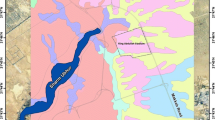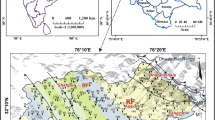Abstract
Few seismic exploration work was carried out in Tibetan Plateau due to the characteristics of alpine hypoxia and harsh environmental protection needs. Complex near surface geological conditions, especially the signal shielding and static correction of permafrost make the quality of seismic data is not ideal, the signal to noise ratio (SNR) is low, and deep target horizon imaging is difficult. These data cannot provide high quality information for oil and gas geological survey and structural sedimentary research in the area. To solve the issue of seismic exploration in Tibetan Plateau, this test used low frequency vibroseis wide-line and high-density acquisition scheme. In view of the actual situation of the study area, the terrain, the source and the different observation system were simulated, and the processing technique was adopted to improve the quality of seismic data. Low-frequency components with a minimum of 1.5Hz of vibroseis ensure the deep geological target imaging quality in the area, the seismic profile wave group is clear, and the SNR is relatively high, which can meet the needs of oil and gas exploration. Seismic data can provide the support for the development of oil and gas survey in the Tibet plateau.
Similar content being viewed by others
References
Gong, T., Wang, Z. L., Gu, X. D., et al., 2016, Broadband seismic data matching processing: Oil Geophysical Prospecting, 51(3): 457–466.
Guo, Z. J., Li, Y. T., Nan, Z. B., et al., 2008, Relationship between deformation structure and petroleum accumulation and preservation, Qiangtang Basin, Tibet: Petroleum exploration and development, 35(5): 563–568.
He, H. Y., Pu, X. D., Wang, X. Q., et al., 2013, Technologies of vibroseis high efficient acquisition in complex terrain area: Journal of Southwest Petroleum University(Science & Technology Edition), 35(3): 76–84.
Ji, Z. S., Wu, G. C., Yao, J. X., et al., 2018, Suggestions on the strategic selection of petroleum target areas and the tactic breakthrough of the oil and gas exploration in the Tibetan Plateau: Acta Geoscientica Sinica, 39(4): 387–400.
Jia, C. Z., Zou, C. N., Yang, Z., et al., 2018, Significant progress of continental petroleum geology theory in basins of central and western China: Petroleum Exploration and Development, 45(4): 546–560.
Jia, C. Z., 2005, Foreland thrust fold belt features and gas accumulation in Midwest China: Petroleum exploration and development, 32(4): 9–15.
Jiang, Z. T., Zhang, J. Q., Wang, D. J., 2006, Discovery of oil-gas shows in the Nyima area, Tibet, China and its significanc: Geological Bulletin of China, 25(9-10):1189–1193.
Li, Y. L., Wang, C. S., Zhu, L. D., et al., 2010, Discovery of oil shale in the Nima basin, Tibet, China and its significance: Geological Bulletin of China, 29(12):1872–1874.
Li, Z. X., Wei, H. W., Ma, L., et al., 2017, Vibroseis acquisition tests in Qiangtang Basin: Oil Geophysical Prospecting, 52(2):199–208.
Mi, W. T., Zhu, L. D., Yang, W. G., et al., 2017, Provenance of the Niiubao formation and its geological implications in the north depression of the Nima Basin in the Tibet: Earth Science, 42(2):240–257.
Nan, Z. B., Zhang, Y. L., Li, Y. T., et al., 2012, Comparative analysis of main depositional basin of Qinghai-tibet plateau and thetys domain: Natural Gas Geoscience, 23(6): 1039–1044.
Niu, L., Li, B., Wang, Y., C., et al., 2015, Residual static corrections for high-density seismic data: Oil Geophysical Prospecting, 50(1): 71–77.
Sun, T., Wang, C. S., Li, Y. L., et al., 2013, Geological characteristics and resource potential of shale gas in Nima Basins, central Tibet: China Mining Magazine, 22(1):72–75.
Sun, T., Wang, C. S., Li, Y. L., et al., 2013, Hydrocarbon potential and molecular organic geochemistry of Niubao formation in Nima Basin, central Tibe: Bulletin of Mineralogy, Petrology and Geochemistry, 32(2):243–251.
Ten Kroode, F., Bergler, S., Corsten, C., et al., 2013, Broadband seismic data—The importance of low frequencies. Geophysics, 78(2), WA3–WA14.
Tian, Y. K., Li, G. L., Liu, H., et al., 2016, Geophysical response characteristics of gas hydrate in Har Hu region based on low-frequency vibroseis data: Chinese Journal of Ggeophysics, 59(11): 4287–4296.
Wang, C. S., Li, Y. L., Li, Y. T., 2006, Discussion on evaluation of oil and gas resources in Qinghai-Tibet Plateau: Acta Petrolei Sinica, 27(4): 1–7.
Xu, X., H., Qu, G., Z., Zhang, Y., et al., 2016, Groundroll separation of seismic data based on morphological component analysis in two-dimensional domain: Applied Geophysics, 50(1): 116–126.
Yilmaz, O., 2001. Seismic Data Analysis. //Processing, Inversion, and Interpretation of Seismic Data Vol.1&2. Society of Exploration Geophysics.
Yuan, S., Wang, S., Luo, C., et al., 2018, Inversion-based 3-D seismic denoising for exploring spatial edges and spatio-temporal signal redundancy: IEEE Geoscience and Remote Sensing Letters, (99): 1–5.
Yuan, S., Su, Y., Wang, T., et al., 2018, Geosteering phase attributes: a new detector for the discontinuities of seismic images: IEEE Geoscience and Remote Sensing Letters, (99): 1–5.
Yuan, S., Wang, S., Ma, M., et al., 2017, Sparse Bayesian learning-based time-variant deconvolution: IEEE Transactions on Geoscience and Remote Sensing, 55(11): 6182–6194.
Yuan, S. Y., Wang, S. X., and Li, G. F., 2012, Random noise reduction using Bayesianinversion: Journal of Geophysics and Engineering, 9(1): 60–68.
Zhang, C. H., 2008, Innovation on oil exploration expertise and integrated iogistics support boost Tibetan discoverie: China Mining Magazine, 17(1): 13–15.
Zhang, C. H., Qiao, D. W., Li, S. Z., et al., 2011, Integration of oil and gas geophysical exploration technologies for geologically complex areas: Chinese Journal of Ggeophysics, 54(2): 374–387.
Zhang, H. J., Zhou, H., Abd El-Aal, A. K., et al., 2012, The anti-correlation method for removing harmonic distortion in vibroseis slip-sweep data: Applied Geophysics, 9(2), 159–167.
Acknowledgements
We are grateful to Wang Jianmin, an expert of Daqing Oilfield Exploration and Development Research Institute, for his guidance and help in the process of writing this paper.
Author information
Authors and Affiliations
Corresponding author
Additional information
This work was supported by Nation key R&D program (No. 2016YFC060110305) and Geological and mineral investigation and evaluation special project (No. DD20160160 and No. DD20160181).
Tian Yu-Kun Ph.D. graduated from China University of Petroleum (Beijing) in 2013. He is currently working in the Oil and Gas Survey of China Geological Survey. His main research interests are seismic data processing and reservoir inversion.
Rights and permissions
About this article
Cite this article
Tian, YK., Kang, Hx., Cao, J. et al. Experiments on excitation and data processing of low-frequency vibroseis in permafrost area of the tibetan plateau. Appl. Geophys. 17, 834–843 (2020). https://doi.org/10.1007/s11770-018-0714-5
Received:
Revised:
Published:
Issue Date:
DOI: https://doi.org/10.1007/s11770-018-0714-5




